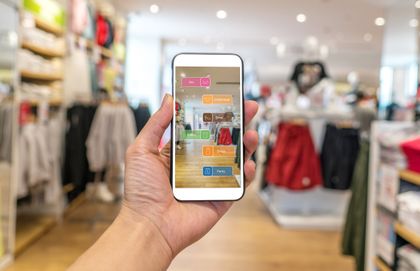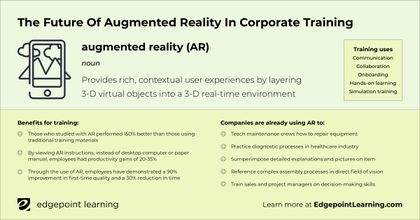Your Guide To The Future Of Augmented Reality In Corporate Training
Quincy Conley, Ph.D.
🍿🍿🍿 13 min. read
Augmented reality (AR) is well on its way of being considered a mainstream technology that will soon become part of our everyday lives. It's already begun to change how marketing, advertising, and entertainment industries operate. Despite the growing attention given to the potential of AR, I feel like its potential in the workplace has yet to be realized. Here's what we can expect when it comes to augmented reality in corporate training in the years to come, along with examples of how it's already being used today.
What is augmented reality (AR)?
AR technologies can provide rich, contextual user experiences in ways that have not been previously possible. An augmented reality program layers 3-D virtual objects into a 3-D real-time environment. In other words, AR is to superimpose images, audio and other objects on top of the real world.
A notable research leader on AR defines it as "an environment that includes both virtual reality and real-world elements” (Azuma, 1997, p. 357). Other technologists and researchers, including myself, have gone on to further clarify that AR also includes physical movement around a real environment, interacting with virtual objects superimposed on the real-world in real time (Chang, Wu, & Hsu, 2013; Conley, 2013; Shelton, 2003).
It is worth differentiating AR from virtual reality or gamification. Virtual reality is a computer-generated environment that is a full simulation of the real world, sometimes called an imaginary world. An AR system supplements only a portion of the environment, and are designed to coexist with the real world. Also, note that the definition of AR is not limited to just sense of sight. It can incorporate other human senses such as hearing, touch, and smell (Azuma et al., 2001) which could lead to richer user experiences. Gamifiction can be a part of augmented reality in corporate training, but it can also complement a more traditional eLearning course.
AR has been around longer than most people realize. An early example that you might remember from TV is the FoxTrax system, which was used to highlight the hard-to-see hockey puck as it moved around the ice. Even earlier than that, you may remember seeing AR while watching the evening news. AR was used for during a news broadcast to indicate the names of the reporters or location of the scene. In addition to television networks, movie production studios have been doing similar things with graphics for decades (Cavallaro, 1997).
How does augmented reality work?
AR uses a camera, computer, and software to alter a viewer’s perception of the world around them.
The camera’s job is to feed images to the computer to process the image. The computer retrieves information from the Internet, and then projects data from the computer onto an object in front of the user; which can be a computer monitor, a wall, or even a person. Lastly, the software seamlessly integrates the process for the user and allows them to interact with the technology (Azuma, 1997).
The major components of today’s AR systems are:
- A microprocessor
- Software
- A camera
- A display screen
Usually, the camera and display screen are fitted for the user with goggles of some sort. However, as long as the user looks through a display screen, the AR device will augment whatever he or she looks at with or without goggles. Conversely, the microprocessor with software can come in many forms, i.e. a desktop, laptop computer, or cell phone.

Current uses of augmented reality
The technology behind augmented reality for corporate training has already been shown to have many purposes, most widely used in marketing and entertainment so far.
AR for shopping
Rayban, the popular eyewear manufacturer, offers an online application that allows shoppers to see themselves wearing the sunglasses before buying or even having to see them in person. Executives of the brand have stated that this function has helped drive up sales and shopping satisfaction over their competitors. Brilliant idea, right?!?
Home decorating vendors have also begun to take advantage of this trend. Just by downloading an AR app, DIY’ers shopping at Build.com can re-design a space all in the palm of their hand. Using AR technology, users can see what color paint would look like on walls. They can also see and adjust furniture around a room (without the sore back from actually moving it).
AR in entertainment
Video game companies are quickly hopping aboard the augmented reality trend, too. Major gaming console manufacturers like Nintendo and Microsoft are leading the charge, because they realize AR can free gamers from their couches and usher them into the real world to play.
For example in the game Human Pac-Man, users chase after each other in real life while wearing goggles that make them look like characters in Pac-Man. Digital Trends provides a list of the top 10 best AR apps for mobile entertainment (Jansen, 2018).
Some of the more notable AR games are:
- Just A Line is a fun doodling app that allows you to decorate wherever you are
- Ingress is an intergalactic fighting game you can play with others
- Zombies Go takes the zombie apocalypse the action to the streets, anywhere and anytime, for runners and walkers alike
- Quiver takes kids coloring books from 2-D to 3-D with animated images
These video games are just the beginning. Probably the most popular AR game ever we've seen is Pokémon Go. Released in 2016, the mobile AR game instantly became a sensation. All across the globe, people took to the streets to find and capture various Pokémons. Consider it a scavenger-hunt game that uses virtual objects. You could use your phone to "locate” Pokémons around town, and gamers would use their phones to find these invisible objects.
Other uses of AR
There are many other augmented reality apps out there -- and many more in development. According to Tom’s Guide, some of the most popular AR apps currently are:
- Google Lens helps to identify objects in your photos
- BBC Civilisations AR to take a history lesson
- Mondly for learning a new language
- YouCam Makeup for fashion assistance
The future of augmented reality in corporate training
In the very near future, it is conceivable that you will clock in, check email, and create a task list all with the wave of your hand. Augmented reality in corporate training has arrived.
Investments in AR applications for the workplace are at full speed (Faldi, 2018; Sharma, 2018). A recent economic research study predicts that spending on augmented reality in corporate training each year through 2021 will double totaling well over $200 billion (Sait, 2018). This financial explosion is attributed to the recently realized potential of AR to help businesses across a range of sectors perform more effectively and efficiently.
Technology prognosticators posit that the highly visual and interactive format has already shown strong signs of helping companies solve employee performance issues in ways not previously possible (Sharma, 2018).
Augmented reality training ideas
Augmented reality in corporate training has been shown to improve critical aspects for an organization such as communication, collaboration, training, and more. Here's some of the leading augmented reality training ideas for tomorrow's corporate training spaces.

Communication
There is no shortage of enterprise communication solutions designed to help companies conduct business. It is rare for an organization to not use video conferencing, instant messaging, or screen sharing tools to foster collaboration and problem-solving. However, AR can go beyond to increase efficiency in the workplace.
Instead of trying to verbally describe how to fix a problem with a product, an employee can quickly show a colleague (or customer) the solution using AR (Ismail, 2018). Simply viewing a product can be done using other communication tools, but AR can seamlessly provide a common view and interactive experience that multiple people can view and manipulate regardless of their location (Dell EMC, 2018). Together, that is what makes AR unique for improving organizational communication.
Collaboration and onboarding
Mixed with standard communication tools, AR can improve workplace collaboration and community, which are considered essential for any organization’s health (Mirt, 2018).
By combining sight, sound, and touch, remote employees’ sense of community can be fostered in ways closer to what a traditional office setting can offer. Through 3-D simulations, AR can provide new hire trainees a more authentic view of their job tasks and responsibilities.
This inevitably reduces the time of assimilation into their role and organizational culture, at the same time decreasing the runway for them to be more productive. Plus, working with AR is more fun than stuffy lectures (Mirt, 2018).
Training
It is apparent how AR can dramatically increase communication proficiencies. AR enthusiast Faldi (2018) describes how:
“AR enables immersive training without leaving the workplace, it provides new ways for trainers to illustrate, demonstrate, and explain. It is well documented that hands-on learning is more effective for many learners. After completing a task guided by AR (or a combination of AR and expert), trainees are much more likely to recall the necessary steps the next time they perform the task.”
This hyper-connectivity tool is key to creating next-generation communication connections. Adopting augmented reality in corporate training can strengthen collaboration pathways internally (externally), making room for new opportunities for organizational innovation and differentiation (Faldi, 2018; Newman, 2016).
Augmented reality training examples in today's workplaces
To grasp and maintain a competitive edge, it is necessary for businesses to anticipate trends that may impact their organization. AR as an emerging technology for training is definitely a movement to watch closely.
Here's some of the innovative ways augmented reality in corporate training is already being used.
Maintenance repairs
ThyssenKrupp leverages the Microsoft HoloLens to train maintenance crews how to repair elevators while viewing AR digital overlays of manuals and guides.
The technicians in the field also have the ability to collaborate with remote experts using the technology so offsite workers can see what the engineers are seeing and advise accordingly. An article on Forbes gives even more examples of this type of AR training.
Assembly processes
Similarly, at Boeing, AR headsets are used by employees to view each step of the complex assembly process of an aircraft directly in their field of view without having to repeatedly refer to a computer.
Assembly time has been reduced by 25% and reduced the error rate to nearly zero (Kroc, 2017).
Diagnostic software
Medical Surgeon Simulator CPR allows users to go online and download their software to practice diagnoses on patients.
The software is used in conjunction with a webcam that recognizes the symptoms of a patient and then displays related video on the user’s computer screen. If the user moves the webcam over a patient and his or her symptoms, the 3-D figure on the screen will provide suggested actions to treat possible ailments.
AR unlocks the potential to put medical professionals in situations otherwise difficult to recreate (i.e., open-heart surgery)—without risking a patient’s life (Newman, 2016).
Healthcare assistant
AccuVein is an AR handheld device that allows nurses and doctors to scan a patient’s body to make a vein appear visible.
According to a study presented at the Infusion Nurses Society Conference, there was a 45% reduction in escalation calls following the deployment of this AR device. Plus, 81% of nurses reported that using AccuVein resulted in an improved ability to cannulate (the procedure to introduce a thin tube into a vein) (Ismail, 2018).
Automotive overlay
Bosch Auto Parts created their own AR platform to provide a composite view of intricate automotive parts.
Using a mobile device to view CAP, the technician can view useful additional information with detailed explanations, pictures, and drawings overlaid on top of the live image of a part.
Soft skills training
Finally, one of the more interesting augmented reality in corporate training examples is from Arcane Technologies. They've developed an AR head-mounted display for training sales and project management personnel on decision-making skills.
The ability to superimpose virtual objects on the real world while undergoing a complex project has been shown to be a huge help for salespeople and their customers while developing their decision-making skills. Same goes for engineers, designers, and other professions where team-work and decision-making come into play. AR has the innate ability to visualize abstract ideas in concrete ways to make plans and designs more real (Faldi, 2018).

Potential benefits of augmented reality in corporate training
The impact of AR in training is already proving hugely successful. A study conducted by Blippar, AR thought leaders, found those who studied using AR performed 150% better than those using traditional paper-based training materials (Sharma, 2018).
Evidence also shows that in manufacturing or assembly-type situations where employees use AR applications to view step-by-step instructions, instead of referring to a desktop computer or paper manual, routinely show productivity gains of between 20% and 35% (Kroc, 2017).
Research from Boeing has also supported that through the use of augmented reality in corporate training, employees have demonstrated a “90 percent improvement in first-time quality and a 30 percent reduction in the time required to complete the job” (Ismail, 2018).
Lastly, follow-up research to the Boeing AR applications conducted by Upskill, an AR software company, regularly shows that AR can improve employee productivity by double-digit percentages. Considering the implications behind these findings, that represents millions of dollars in cost savings for a business.
Challenges of augmented reality in corporate training
Notwithstanding recent progress, augmented reality in corporate training still has some challenges to overcome. For instance, most AR applications are directly tied to GPS. They need to be able to detect your location in order to provide information that is relevant to you. However, GPS is only currently accurate to within 30 feet and is sometimes limited by obstructions. Researchers are working to overcome this issue by developing AR devices with improved image recognition technology (Javornik et al., 2019).
Another limitation is that people or companies may not want to rely on their smartphones to superimpose information. Although smartphones are improving, many of them have too small screens for some people’s liking. For that reason, it is much more likely that a wearable device will be the direction for augmented reality for corporate training. Or better yet, there is a possibility of AR lenses and glasses that will provide users with more convenient, expansive views of the world around them (Kim, Hwang, Kim, Ahn, & Chung, 2016).
Towards the future of augmented reality in corporate training
Despite these challenges, once again imagine the possibilities. If you work in construction, you can save on materials by using virtual markers to designate where a beam should go or which structural support to inspect. Paleontologists working in shifts to assemble a dinosaur skeleton could leave virtual notes to team members on the bones themselves. Doctors could overlay a digital image of a patient's X-rays onto a mannequin for added realism.
The possibilities for augmented reality in corporate training are exhilarating. Renowned tech experts think AR has the potential to be the next great technology that shapes the future (DisruptHR, 2018; Kroc, 2017).
Thought leaders on the topic believe that AR has already delivered on the promise of being able to impact the workplace by increasing productivity, enhancing training, and improving safety for employees (Faldi, 2018).
Are you ready to learn more? EdgePoint Learning specializes in custom solutions specially tailored to your employees’ needs. With a combination of traditional, digital, and mobile-first training options, EdgePoint Learning can help you ready your learning content for a future AR-enabled pathway.
Contact us today to talk about our custom training solutions!
Learn more
- Augmented reality is an always-changing world. Beyond this post, you can learn more about augmented reality in the following studies and articles.
- Azuma, R. T. (1997). A survey of augmented reality. Presence: Teleoperators and Virtual Environments, 6(4), 355–385.
- Azuma, R. T., Baillot, Y., Behringer, R., Feiner, S., Julier, S., & MacIntyre, B. (2001). Recent advances in augmented reality. IEEE Computer Graphics and Applications, 21(6), 34–47.
- Blippar. (2018). Easily create your own interactive augmented reality experiences. Retrieved from https://www.layar.com/
- Brodkin, J. (2010). The future of human-computer interaction. Southborough, MA: Emotiv Systems.
- Cavallaro, R. (1997). The FoxTrax hockey puck tracking system. IEEE Computer Graphics and Applications, 17(2), 6–12.
- Chang, H.-Y., Wu, H.-K., & Hsu, Y.-S. (2013). Integrating a mobile augmented reality activity to contextualize student learning of a socioscientific issue. British Journal of Educational Technology: Journal of the Council for Educational Technology, 44(3), E95–E99.
- Conley, Q. (2013). Exploring the impact of varying levels of augmented reality to teach probability and sampling with a mobile device (Doctoral dissertation). Retrieved from https://search.proquest.com/docview/1475262379
- Dell EMC. (2018, August 30). Coming to a workplace near you — Augmented and virtual reality [Web log post]. Retrieved from https://www.computerworld.com/article/3301879/coming-to-a-workplace-near-you-augmented-and-virtual-reality.html
- DisruptHR. (2018, March 7). AR Is already in your workplace, how will HR use it? Talent Management & HR. Retrieved from https://www.tlnt.com/ar-is-already-in-your-workplace-how-will-hr-use-it/
- Eaton, K. (2009). MIT’s Sixth Sense machine makes reality better. Retrieved from https://www.fastcompany.com/1150913/mits-sixth-sense-machine-makes-reality-better
- Faldi, F. (2018, August 27). Augmented reality in the workplace. My TechDecisions. Retrieved from https://mytechdecisions.com/unified-communications/augmented-reality-in-the-workplace/
- Hemming, A. (2019, March 2). AR and VR need to move from what developers like to what consumers want [Web log post]. Retrieved from https://venturebeat.com/2019/03/02/ar-and-vr-need-to-move-from-what-developers-like-to-what-consumers-want/
- Ismail, K. (2018, October 3). 8 augmented reality companies changing the digital workplace [Web log post]. Retrieved from https://www.cmswire.com/digital-workplace/8-augmented-reality-companies-changing-the-digital-workplace/
- Jansen, M. (2018). Escape reality with the best augmented reality apps for Android and iOS. Retrieved from https://www.digitaltrends.com/mobile/best-augmented-reality-apps/
- Javornik, A., Kostopoulou, E., Rogers, Y., Fatah gen Schieck, A., Koutsolampros, P., Maria Moutinho, A., & Julier, S. (2019). An experimental study on the role of augmented reality content type in an outdoor site exploration. Behaviour & Information Technology, 38(1), 9–27.
- Kim, T., Hwang, S., Kim, S., Ahn, H., & Chung, D. (2016). Smart contact lenses for augmented reality and methods of manufacturing and operating the same. U.S. Patent 20160091737:A1. U.S. Patent and Trademark Office. Retrieved from https://patentimages.storage.googleapis.com/d5/ba/5c/5e8ce33928c19c/US20160091737A1.pdf
- Kroc, N. (2017, September 20). Augmented reality comes to the workplace. Society for Human Resource Management. Retrieved from https://www.shrm.org/hr-today/news/hr-magazine/1017/pages/augmented-reality-comes-to-the-workplace.aspx
- Mirt, J. (2018, June 21). 5 ways you can use virtual reality in the workplace Web log post. Retrieved from https://www.viar360.com/blog/5-ways-can-use-virtual-reality-workplace/
- Newman, D. (2016, September 20). Hyper-training and the future augmented reality workplace. Forbes Magazine. Retrieved from https://www.forbes.com/sites/danielnewman/2016/09/20/hyper-training-and-the-future-augmented-reality-workplace/
- Niantic. (2016). Catch Pokémon in the real world with Pokémon GO! Retrieved from https://pokemongolive.com/
- Sait, D. (2018, July 12). Study says virtual reality spending will double each tear through 2021. My TechDecisions. Retrieved from https://mytechdecisions.com/video/study-says-virtual-reality-spending-will-double-each-year-through-2021/
- Sharma, T. (2018, April 20). How AR in the workplace can enhance training [Web log post]. Retrieved from https://www.blippar.com/blog/2018/04/20/how-augmented-reality-workplace-can-enhance-training
- Shelton, B. E. (2003). How augmented reality helps students learn dynamic spatial relationships (Doctoral dissertation). Retrieved from https://search.proquest.com/docview/305274787
- Smith, S. L., & Corpuz, J. (2018). Best augmented reality apps. Retrieved from https://www.tomsguide.com/us/pictures-story/657-best-augmented-reality-apps.html
